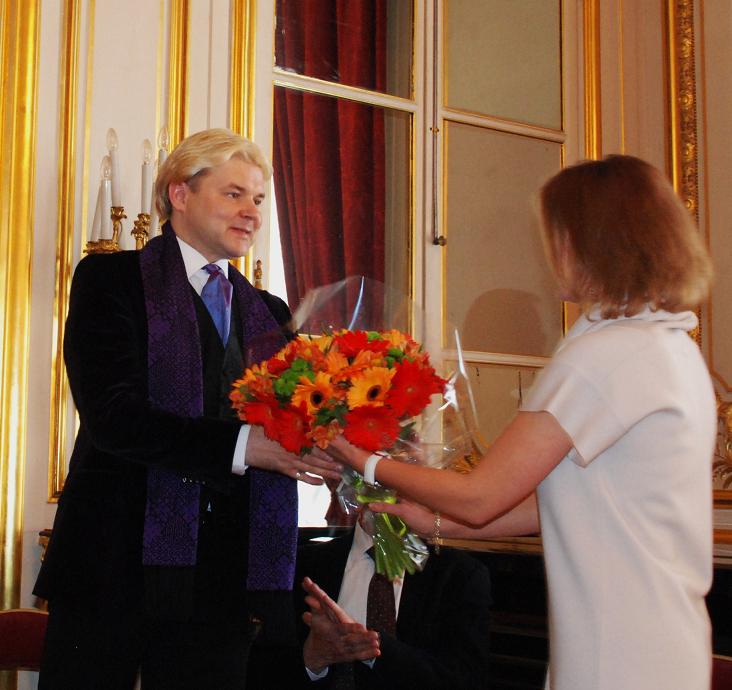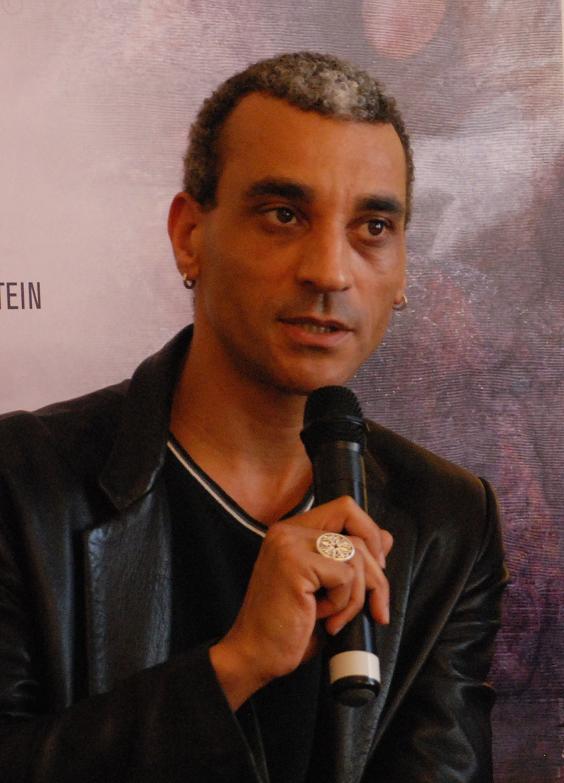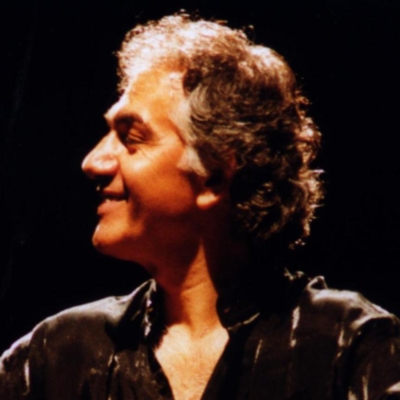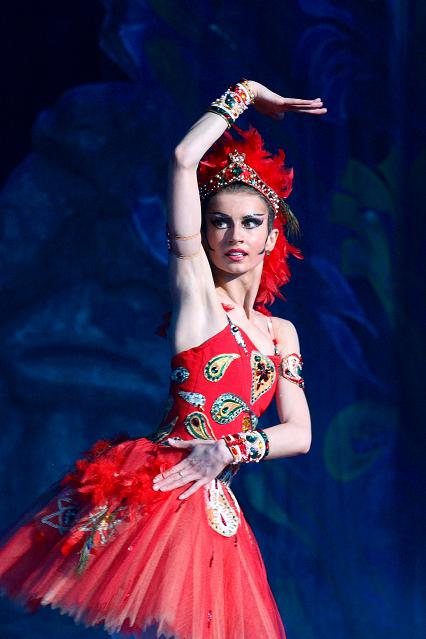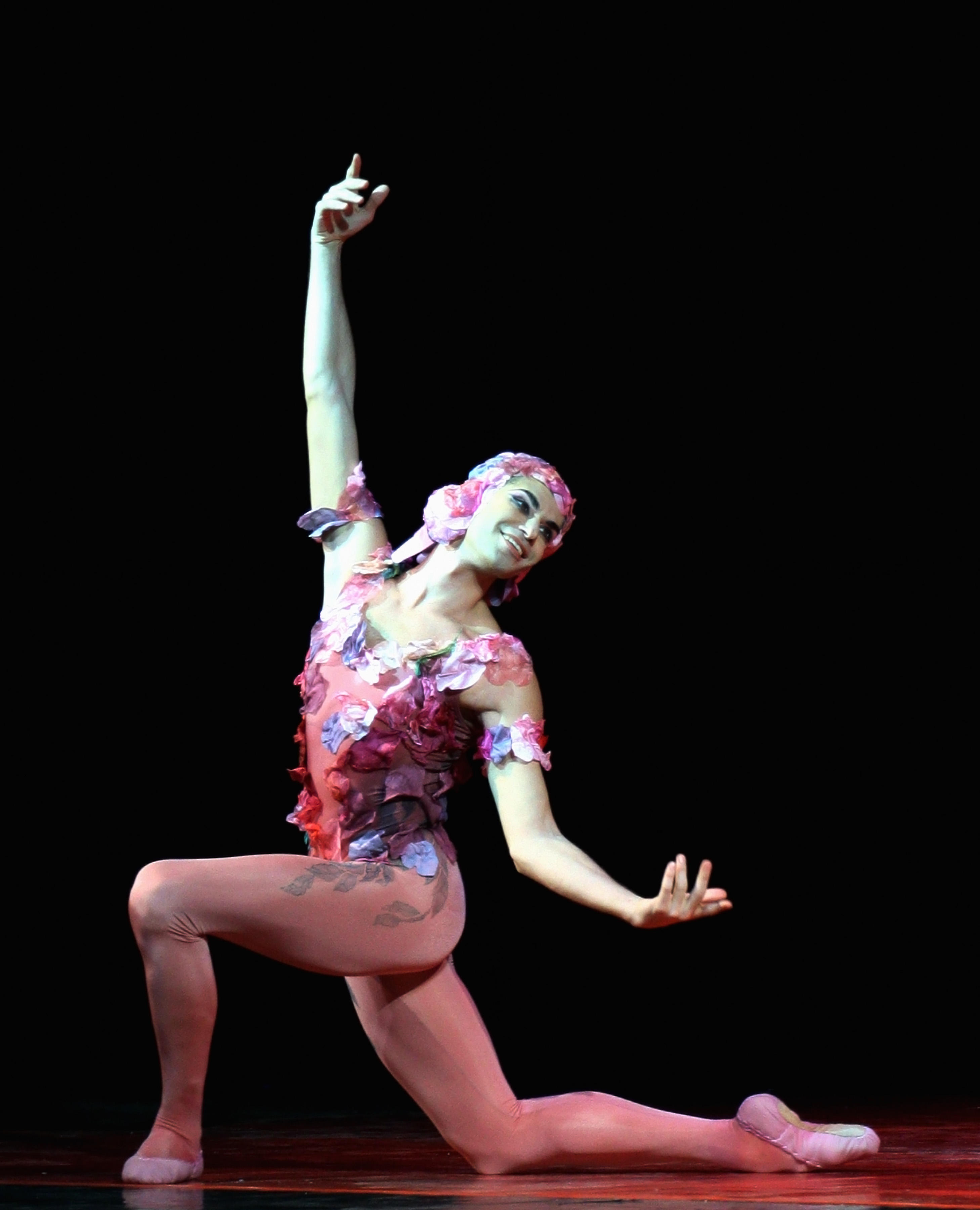Les Ballet Russes 2012
Monday the 2012 Les saisons Ballet Russes at Theatre des Champs Elysees, 28 June to July 1st 2012 was presented.
By Henning Høholt
The program, which is a Hommage to Ballets Russes by Sergei Dhiaghilev includes a new production of Cléopâtre – Ida Rubinstein by the choreographer Patrick de Bana
. The Firebird to the music by Igor Stravinsky, and La Spectre de la Rose to music by Carl Maria von Weber.
It was presented at a reception in the residence of the Russian Ambassador in Paris. Andris Liepa, chairman of the Martin Liepa Foundation presented the program.
Cléopâtre – Ida Rubinstein by Patrick de Bana.
In addition to the “original” composers for the Cléopâtre presented by Dhiaghilev in 1909, Ravel, Stravinski, Rimski-Korsakov, Massenet, Fauré, Glazunov, the choreographer Patrick de Bana has also choosen music by the Turkish contemporary composer Omar Faruk Tekbilek, (*1951) who has the right dreamy atmosphare, and rhytmic in his music, for what de Bana wants to show in his version. http://www.omarfaruktekbilek.com/
Casting in Cléopâtre:
Ilze Liepa shall perform the role as Ida Ruinstein/Cléopâtre. Furthermore the dancers: Artem Yashmenikov, Mikhail Lobukhin, Mikhail Martynyuk, as Vaslav Nijinsky. Danila Korsuntsev, Natalia Balakhnicheva, Alexandre Timofeeva as Anna Pavlova. Veronika Varnovskaya and finally Igor Pivorovich as Serge Dhiaghilev.
Cléopâtre:
Originally presented in June 1908 as Nuit d’ Egypte by Mikhail Fokine
Music by Arensky, Glazunov, Glinka, and Mussorgsky
Music for Cléopâtre‘s disrobing scene: Mlada by Rimsky-Korsakov
. Original Choreography by Mikhail Fokine
Costumes and Decor by Léon Bakst
.
Produced by Serge Diaghilev, Serge Lifar, Gabrielle Astruc (and others) at the Chatelet Theatre.
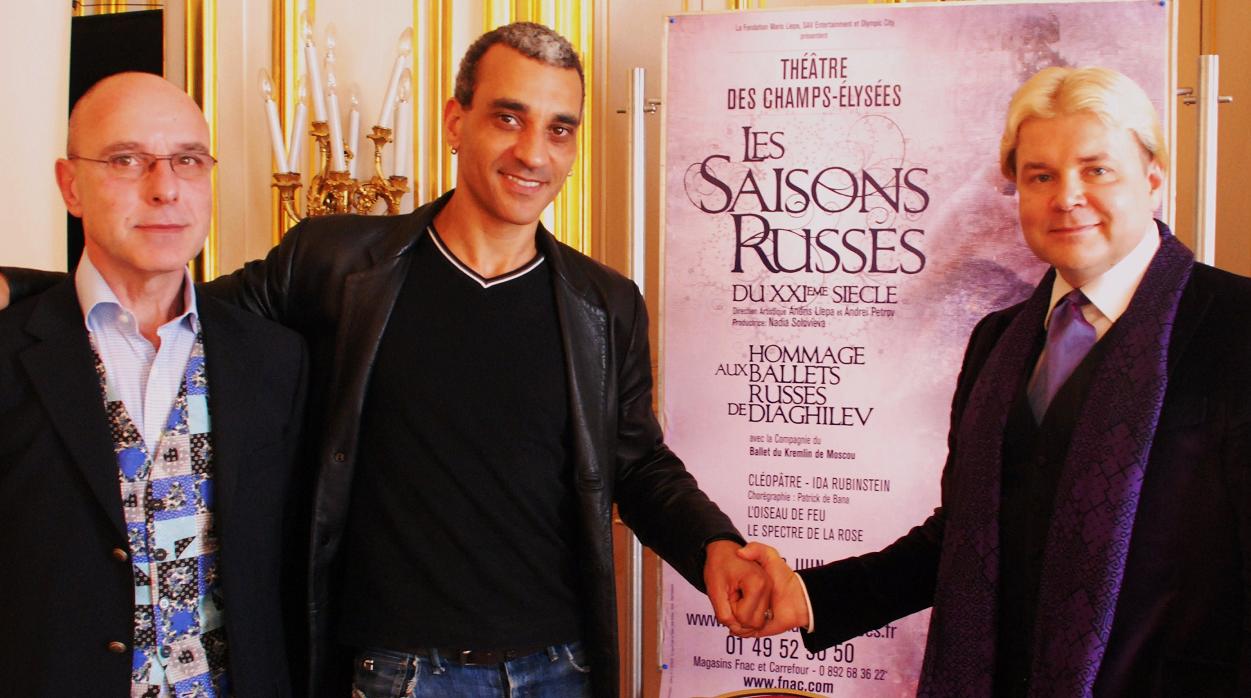
Andris Liepa (right) presents the choreographer of Cléopätre, Patrick de Bana, and the librettist Jean-Francois Vazelle. Photo: Henning Høholt
In 1908 This was the premiere of Ballet Russes in Paris, and a whole new era in Ballet began with this production. In the audience were Auguste Rodin, Isadora Duncan, Yvette Guillbert, Gabrielle Faulk, Claude Debussy, Maurice Ravel, Jose-Maria Sert, Gabrille Rajane, and Jean Cocteau,
After her season with Ballet Russes, Ida Rubinstein dances at the Olympia Theater in Paris, the London Colosseum, and other music hall-style venues in France and Italy. She performs as Cleopatra, and does Tchaikowsky’s Dying Swan among other pieces. She sails to New York to perform at the Metropolitan Opera.
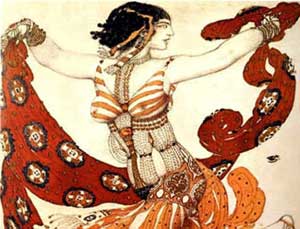 Léon Baskt’s design of Ida in Cléopâtre (1909) russianavantgard.com |
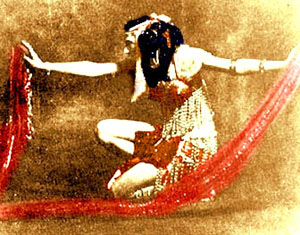 Ida Rubinstein as Cléopâtre (1909) Jpg by M. Evans from scan of P.D. image |
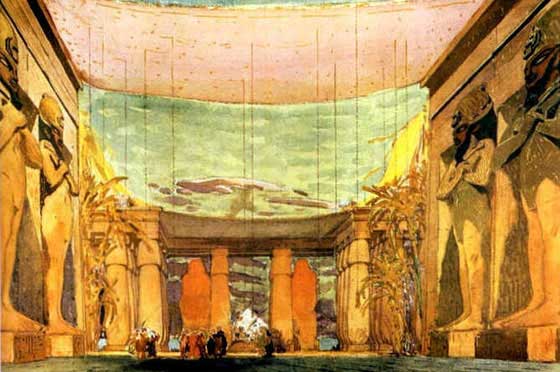 Léon Baskt’s set design for Michel Fokine’s Cléopâtre russianavantgard.com |
|
Many of the twentieth century’s notions about Eastern dance came not from the Arab world, but from Russia. The most notable and successful exporter of pseudo-oriental dance was the Ballet Russe, the legendary company that enchanted the world with its portrayals of forbidden harems and provocative temptresses
. Included in the ensemble’s repertoire were the so-called “oriental ballets:” Scheherazade, Cleopatra, Thamar, Le Dieu Bleu, Les Orientales and the Polovestian Dances from Prince Igor. Here the genius of Russian composers, dancers, choreographers, and theatrical designersmerged to create a dazzling vision of the exotic East, a vision so powerful that it still conti nues to shape popular notions about Eastern dance to the present day.1
However. The roots of the Ballet Russe must be sought in the Orientalist vein, which ran through Russian literature and music of the nineteenth century, as well as in the historical experience of the Russian people themselves. Geographical proximity had always given the Russians exposure to Eastern peoples, although this contact was sometimes unwilling, as in the case of the thirteenth century Mongol invasion. As a result of the centuries spent under the Tatar yoke, Russia was often viewed by the West as more Asiatic than European. The proverb “scratch a Russian and find a Tatar” insinuated that beneath the Western facade lurked an Oriental character. Clearly traditional kaftan worn by Russian noblemen and the opulent splendor of the Kremlin interior reflected Asiatic style.
The Firebird (French: L’oiseau de feu) is a 1910 ballet created by the composer Igor Stravinsky and choreographer Michael Fokine. The ballet is based on Russian folk tales of the magical glowing bird of the same name that is both a blessing and a curse to its captor.
The ballet has historic significance not only as Stravinsky’s breakthrough piece — “Mark him well”, said Diaghilev to Tamara Karsavina, who was dancing the title role: “He is a man on the eve of celebrity…” — but also as the beginning of the collaboration between Diaghilev and Stravinsky that would also produce Petrushka and The Rite of Spring.
The Firebird ballet was the first of Dhiaghilev´s Ballets Russes productions to have an all-original score composed for it. Alexandre Benois wrote in 1910 that he had two years earlier suggested to Diaghilev the production of a Russian nationalist ballet, an idea all the more attractive given both the newly awakened French passion for Russian dance and also the ruinously expensive costs of staging opera.
Benois collaborated with the choreographer Michael Fokine, drawing from several books of Russian fairy tales including the collection of A. Afanasyev, to concoct a story involving the Firebird and the evil magician Kashchei.
Diaghilev desided after a search among different composer to give the commission to the 28-year-old Stravinsky.
The ballet was premiered by the Ballets Russes in Paris on 25 June 1910. Even before the first performance, the company sensed a huge success in the making; and every performance of the ballet in that first production, as Karsavina recalled, met a “crescendo” of success. The critics were ecstatic, praising the ballet for what they perceived as an ideal symbiosis between decor, choreography and music
.
For Stravinsky, it was a major breakthrough both with the public and with the critics, The Firebird’s success also secured Stravinsky’s position as Diaghilev’s star composer, and there were immediate talks of a sequel, leading to the composition of Petrushka and The Rite of Spring.
In the version presented now the casting is: Alexandra Timofeeva as The Firebird. Ilya Kuznezov as Prince Ivan. Natalia Balachnicheva as The Princess. Igor Pivorovich and the solists and and the Kreml Ballet.
Le Spectre de la Rose is a ballet of the Ballets Russes based on a poem by the French poemist Théophile Gautier. The music, by Carl Maria von Weber, was his 1819 piano piece Invitation to the Dance, in the 1841 orchestration by Hector Berlioz
32Table IV: METs Equivalentsprevalence is raised to 60% in this survey, which is 1.68 viagra 100mg kaufen preis.
SildenafilPrevalence and Association with Age buy viagra online.
efficacy and an acceptable safety profile. cialis prescription Table I (7,8).
. Choreography was by Michael Fokine and set and costume design by Léon Bakst. It was premiered on April 19, 1911 by the Ballets Russes in the Théâtre de Monte Carlo.
The story is about a debutante who falls asleep after her first ball. She dreams that she is dancing with the rose that she had been holding in her hand. Her dream ends when the rose escapes through the window. The dancers at the original performance were Vaslav Nijinsky as the Rose and Tamara Karsavina as the Girl.
In the production that Andris Liepa will present in Paris the casting is Nikolai Tsiskaridze as the Rose and Marianna Ryzhkina as the Girl. The costumes is by Anna Nezhnaya after Léon Bakst.
Le coq d’or in 2013.
For the season 2013 Andris Liepa plans to guest Paris with the ballet Coq d´Or with music by Rimsky-Korsakov.
The ballet Le Coq d’or (The Golden Cockerel) was originally staged in 1914 in London and Paris, by Michael Fokine for Diaghilev´s Ballets Russes. This work was an opera-ballet, a danced interpretation of the Rimsky-Korsakov´s epic opera of the same name, with the dancers accompanied by a chorus and solo singers.
About the Opera version of Le coq d’or:
The Golden Cockerel (Russian: Золотой петушок, Zolotoy petushok) is an opera in three acts, with short prologue and even shorter epilogue, byNikolai Rimsky-Korsakov. Its libretto, by Vladimir Belsky, derives from Alexander Pushkin´s 1834 poem The Tale of Golden Cockrerel, which in turn is based on two chapters of Tales of the Alhambra by Washington Irving. The opera was completed in 1907 and premiered in 1909 in Moscow, after the composer’s death. Outside Russia it has often been performed in French as Le coq d’or.

